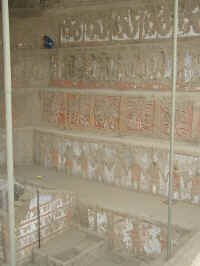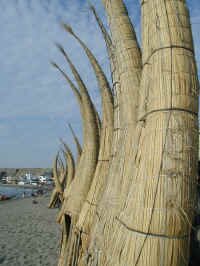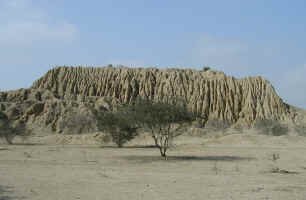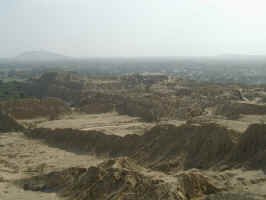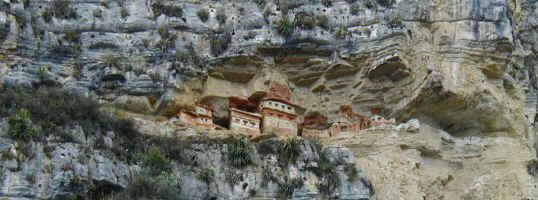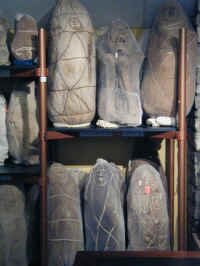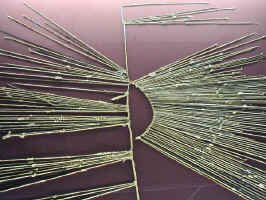Sept. 25-Oct. 2, 2006
Last night we had our first opportunity to spend the night at a gas station, or Grifo as they are called here. After finally turning back onto the Pan Americana, we thought we would find a spot on the beach. No such luck and after driving another hour trying to find someplace off the highway, we just decided to bite the bullet and stop. It wasn't pretty and it wasn't quiet but that's what ear plugs are for.
After an actually restful night, we headed for the ruins of Huaca del Sol and Huaca de la Luna. "Huaca" is commonly interpreted as meaning "place of". These are two huge adobe structures built by the Moche people some 2,000 years ago. Huaca del Sol contains 100 million adobe bricks and is considered one of the largest adobe structures in the world. It was also the administrative center of the complex and little excavation has been done there.
Huaca de la Luna however, was the religious center and contains stunning friezes and reliefs of the god Ai-Apaek done in red, black and yellow. Ai-Apaek is also referred to as "The Decapitator" as he is always shown with a knife in one hand and a head in the other.
| There are also works depicting warriors, prisoners, dancers and various fish and insect gods, most shown at roughly life size. There are several layers which comprise La Luna, each one newer than the lower one. Approximately every one hundred years, the inhabitants would enlarge the size of the temple thereby covering up the earlier works and thus unintentionally preserving them for us to see. Ongoing excavations continue to reveal fabulous artwork. |
|
After leaving the Huacas, we continued north a few kilometers past Trujillo, Peru's third largest city, and found the beach town of Huanchaco. This is a small town that survives on tourism. There are many hotels and restaurants, a pleasant beach and good surfing. But there are also local fisherman who use individual reed boats, called caballitos de tortora, to ply their craft. These boats are depicted on 2,000 year old Mochica ceramics. Our first afternoon in Huanchaco we watched a fisherman surf his caballito back onto the beach and unload his catch of hundreds of crabs. This is not a tourist stunt, this is their livelihood. |
The next day was basically a rest and errand day. We did travel by bus into Trujillo to visit the town's collection of colonial homes. There are quite a few around the Plaza de Armas and we were invited on a short tour of La Casa Urquiaga which is now owned by a Peruvian bank. The house is beautifully preserved with many of its original furnishings. We heard a parade coming down the street so we stopped to watch. After a minute we realized that the parade was actually celebrating the tourist industry and we found that we were as much a part of the parade as the participants as they all turned to acknowledge us.
The next morning we returned to the outskirts of Trujillo to visit the ruins of the huge Chimu city of Chan Chan. The Chimu rose after the decline of the Moche. The Chimu were Peru's largest pre-Inca empire and its capital was Chan Chan. At its heyday, the 20 sq. km. city housed as many as 60,000 people, but it was abandoned in 1470 and is now mostly adobe rubble as the Chimu cities were also constructed of tens of thousands of bricks. Today the highway cuts right through the middle of the ruins, and when we looked in either direction we could see adobe ruins for a long ways. Excavations and reconstructions in the main complex of Tschudi show a huge maze of a city with passageways containing carvings of sea otters, birds, fish and fishing nets. Also of interest is the huge open well in the center of the complex where today reeds grow and ducks frolic.
Finally leaving the Trujillo area, we headed north up the Peruvian coast. Our next stop was another Moche ruin called El Brujo. There are three sites, but only one is allowed to be visited. We had to drive through about ten miles of sugarcane fields to reach the site. As we were entering the park, we noticed many, many holes dug in the ground, apparently by huaqueros, looking for tombs to loot. Who knows how many artifacts have been stolen or destroyed by these thieves. In fact there were so many holes that it appeared that every square foot of ground had been searched!
The only site that can be visited, Huaca Cao, is a platform with murals on five levels, similar to Huaca de la Luna, only not as large or dramatic. Our disappointment in what could be seen was tempered by the fact that once we were out of the park, we could wander the area nearby that included burial mounds that had been looted. It was incredibly fascinating but also tragic. Looking closely at the ground, one could see pieces of pottery, ancient textiles and human bones scattering the ground. The scene was similar to one we had seen near Nasca six years ago. It is really sad that there are Peruvians who need to destroy their heritage to make a few dollars and it is even more tragic that the world loses the stories that these ancients had to tell.
Tearing ourselves away, we continued north toward the city of Chiclayo. Even though it was only about 165 km away, (102 mi) all the small towns along the way slowed us down and the drive seemed to take forever. As it was getting closer and closer to sunset, we decided that Chiclayo wasn't in the cards and that we would try to find a nice spot on one of the beaches to the south. Taking a rather roundabout way, we passed through a couple of small towns without finding a spot. Finally, as we were heading toward our last-chance town, we spied a road heading through the dunes toward the ocean. Just as the sun was setting, we found a tranquil spot to spend the night with only the sound of the ocean to disturb us.
In the morning, we were awakened by the sounds of fishermen bringing their caballitos (reed boats) to the beach and launching them through the surf for a day's worth of fishing.
After a leisurely morning walking the along the beach where we spied a couple of dolphin skeletons on the sand, we made our way into the city of Chiclayo to do some shopping and wandering. We enjoyed a great lunch of cabrito - goat, and some fresh fruit juice in the central market area. Then back on the road to visit one of our main goals in Peru - the Museo Tumbas Reales de Sipán, where the gold masks, crowns, jewelry, ceramics and other objects recovered from the royal Moche tombs uncovered at the ruins of the ancient city of Sipán are displayed.
Originally called the Lords of Sipán because two of the tombs held royalty, the museum holds the finds from more than ten tombs located in just one pyramid! We wandered around in awe for nearly three hours, viewing every piece on display until we were exhausted. We'd love to show you some photos, but photography is prohibited in the museum. Some of the great items displayed here were also shown in the National Geographic Magazine.
We are now parked out in front of the ruins at Túcume enjoying a peaceful sunset and the sounds of many birds. In the morning we got up early to view the 26 eroded adobe pyramids located here.
Imagine a 5 story building that has been clawed by some giant monster, that is how the pyramids appear. The drawings and models of the city that can be viewed in the museum helps to give a clearer picture of what the city might have looked like. Here are a couple of the pyramids:
Driving northward we were amazed to find that we drive past several more areas of ancient pyramids, none of which are marked as protected monuments. At least one of the sites has a village built right among the ruins. Talk about not making an effort at preservation.
We're heading eastward, up over the mountains, to the Peruvian Department of Amazonas. Even though we are not actually driving down into the Amazon, our destination is the town of Chachapoyas - home to the ruins of the Chachapoya. The ruins are said to rival those at Machu Picchu. In addition to ruins, there are unique burial "homes" built into the mountainsides where hundreds of mummies where found in the 1990's. Upon arrival in "Chacha" we decided to park our vehicle for a couple of days and take tours to the ruins. We found out that the roads are just awful and we could do an overnight tour for close to the price that our fuel would have cost! So tonight we are parked in a secure parking lot with a guard dog, and tomorrow we head off to see the ruins that we have heard about and wanted to visit since our first visit to Peru 6 years ago.
The Chachapoya people were independent people who lived in very fortress-like cities and co-existed unhappily with the Inca. Many of the ruins in the Chachapoyas area have uniquely Chachapoyan characteristics, but also with Inca influence.
During our visit to Chachapoya country we spent two days driving over incredibly rough and dusty roads, and hiking to remote archaeological sites. The first site we visited was Kuelap. Perched on a limestone mountain, this fortress is surrounded by huge walls and sheer cliffs. We had to park down below and hike up, which was quite breathtaking, literally, as the fort is at an elevation of over 3,000 meters (10,000 ft)!
Inside the fort are some 400 round stone homes, built in a unique style we haven't seen anywhere else. Originally they would have had peaked thatch roofs with raised floors. The floors extend out the sides, providing a lip that protects the bottom of the wall from rain and erosion. Reliefs decorate many of the buildings. There was also a unique structure with rounded walls that start narrow at the bottom and extend outward. This is a very difficult building technique which archaeologists are studying in order to recreate it.
The next day we did an even more difficult hike up to the site at Revash. This site is a collection of house-like tombs built into a cliff that once housed hundreds of mummies. Unfortunately the tombs were looted long ago, but what remains are several intact, colorful buildings, smaller yet similar to the Anasazi of the American Southwest. The cliff face that contains the buildings is a two hour hike from the road and very steep. According to our guide, we hiked up 2km (1 mile) in elevation from where we parked.
| After returning to the car from Revash, we continued on to the community of Leimebamba where a museum has been constructed to house the artifacts recovered from the Laguna de los Condores tombs. Included are more than 225 mummies and 2,000 artifacts. Though it would be easy to say that these artifacts should have remained where they were found, the reality is that it would have been impossible to protect the site once its location became known. |
| The outstanding museum which was created with the help of the Austrian government, has been wonderfully done and holds many exceptional pieces that were miraculously preserved by the microclimate in which they were found. Some of the incredible finds were Kipus which are kind of like a macrame necklace with knots tied in various places. It is believed that these were record-keeping devices similar to a diary that would contain a history of events and were only done by the Inca. The Leimebamba museum has the largest number of Kipus in the world. |
Another interesting feature of this museum is that it was built by the local population. The entire community turned out during construction and built the building with their own hands. Unlike other museums in Peru, the artifacts stayed in the community where they were found so that the tourism the pieces generate stay in and help the community.

